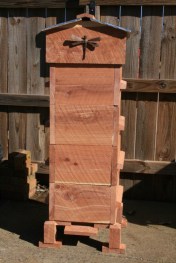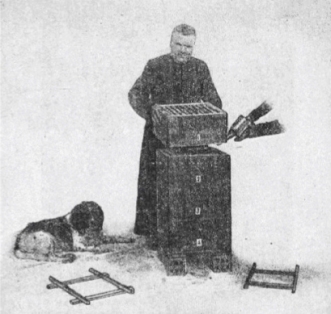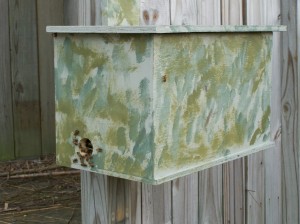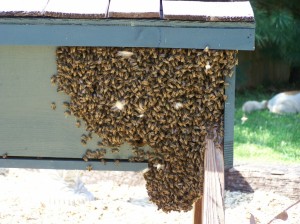Top Bar Hives
Download our Powerpoint presentation on Top bar Hives: Top Bar Hives
How we got started with the bees…
I started with top bar hives completely by accident. I knew nothing about bees. My wife had recently completed the Master Gardener program and brought me home some bee-related literature from there. While searching the internet for bee information, I came across the website of a guy that builds and sells top bar hives. (http://www.organicbeehives.com/) Not realizing how simple they were to build, I ordered one from him. It was around the first week of June when it arrived and I quickly realized that it was too late to buy bees. I found a guy on Craigslist in Nashville who was selling complete hives and I called and asked if he would sell me some bees. He gave me a high price and I accepted it. He told me to bring my new hive to him the next day on my lunch hour and drop it off. He would fill it with bees and I could pick it up after work.
When I showed up with my new top bar hive, he took one look at it and told me that he had never seen a hive like that and the bees couldn’t survive in it. He said as a professional beekeeper, he had to advise me to buy one of his hives and to get rid of my new hive! I reminded him that he had said he’d sell me bees and I wanted them! He hopped in his car and told me to follow him.
We went to a field with five or six hives in it. I hauled my hive up the hill and set it on the ground in front of the one he was standing by and removed some bars. This wasn’t easy because the ground wasn’t level and the bars kept sliding off. He popped the top on a hive and started shaking bees onto and into my hive. This was my first experience around bees and I was a little nervous with no protective gear at all. He wasn’t wearing any either, so I got down and gently raked the bees into my hive with my bare hands. Just when I was getting used to all the bees buzzing around, one flew up my nose and donated her stinger! I guess I was officially initiated! Ibrihim then went to another hive and pulled a couple of frames and gently grabbed the queen and walked over, dropped her in my hive, and told me to close it up. He helped me lug it back to my truck and I tied the top down and followed him back to his house.
When we got there, he told me that he would show me the live queen before I had to pay him. I told him from the little I’d read, the queen was probably dead. We opened the hive back up and he spent about five minutes staring at the five pounds of bee crawling around before he picked the queen up and showed me she was alive and then held out his hand for his money. Once again, he told me the bees would leave this new hive as soon as I got it home and to give him a call when I was ready to buy a “real” bee hive.
I took them home and set them up and proceeded to spend many hours watching them. After about four days, I couldn’t wait any longer and had to open them up. I had been looking in the observation window but it was too dark in there to see much. To my amazement, they had started a couple of small combs. I knew I would have to feed them since it was late in the year, so I fed off and on till Fall. By that time, they had built about fourteen combs and seemed very healthy.
I spent the first Winter expecting the worst, but come Spring, the hive was going strong. In fact, a little too strong. I had set up some bait hives in my yard on about April 5th and on April 7th, I caught a swarm!
..
On April 9th, I stood helplessly by and filmed my own hive swarm. Luckily, they landed in a pine tree within thirty feet of the hive. I was able to shake them into a box and put them in one of the new hives I had built over the winter.
..
A couple of months after starting my first hive, my good friend Greg Tomerlin came over to see them. I had forgotten, but he had been a beekeeper when I had first met him twenty-seven years earlier. He got rid of his hives when he was injured in an accident and could no longer care for them. I’ve never seen him happier than when I popped the first bar and the smell of the hive reached him. He immediately asked me to build him a hive, and he ordered parts for four Langs.
 We are currently keeping two top bar hives and are expanding our operations to about twenty hives. While the top bar hives are enjoyable, we have decided to expand our operation with eight frame medium Langs. My sister currently has two TBHs and another friend has six at his house. They are a wonderful way to learn about bees.
We are currently keeping two top bar hives and are expanding our operations to about twenty hives. While the top bar hives are enjoyable, we have decided to expand our operation with eight frame medium Langs. My sister currently has two TBHs and another friend has six at his house. They are a wonderful way to learn about bees.
More Top Bar Hive info and photos to be added. In the meantime, here are a couple links showing plans for Top Bar Hives similar to what we use:
Lyonsville Fletcher: lyonsvillefletcher.blogspot.com/2009/03/top-bar-pictorial.html
Michael Bush: www.bushfarms.com/beestopbarhives.htm
UPDATE 25 Aug 2012 –
 We’ve had a lot of questions concerning top bar hives since our presentation on them last month at our bee club meeting. We had more questions while working the booth at the county fair last night. Most people wanted to know how to build a top bar hive and where to get plans. Free plans are available at several sites on the internet. Below are a few links:
We’ve had a lot of questions concerning top bar hives since our presentation on them last month at our bee club meeting. We had more questions while working the booth at the county fair last night. Most people wanted to know how to build a top bar hive and where to get plans. Free plans are available at several sites on the internet. Below are a few links:
Unlike Langstroth hives, there are no specific dimensions required for this type hive. There are also no specific rules for type of roof, entrance, sides, follower boards, etc., so you can make them as plain or fancy as you want. The only advice to any of the things mentioned above is that we would strongly recommend the entrance be on the end and not in the middle. If you do your homework, you’ll understand why. The only dimension that is critical is top bar width, and those aren’t set in stone as long as you stay within certain boundaries. Remember, one of the advantages to this type hive is it’s simplicity. No matter what plan you choose, be sure you build all of your own hives to the same dimensions so your parts are interchangeable. This is invaluable.
As any successful top bar hive keeper will tell you, the most important thing is to make sure your bees build straight combs. You can help (and even force) them to do this. If you focus on this from the beginning, you’ll be rewarded down the line.
 One more great piece of advice is this. DO NOT LET SOMEONE TELL YOU THAT TOP BAR HIVES WON’T WORK. THEY WILL. If they tell you that you probably won’t get as much honey from this type hive, they may be correct. But, with correct management, you can get plenty of honey. If you’re going into beekeeping to produce as much honey as possible, you’re probably not going this route anyway. In almost all the cases, negative comments come from people with no experience with this type hive. If they tell you that top bar hives swarm more than other hives, that is also true, unless you manage them correctly to prevent swarms. Top bar hives require more frequent manipulations than Langs, but it is quick and rewarding.
One more great piece of advice is this. DO NOT LET SOMEONE TELL YOU THAT TOP BAR HIVES WON’T WORK. THEY WILL. If they tell you that you probably won’t get as much honey from this type hive, they may be correct. But, with correct management, you can get plenty of honey. If you’re going into beekeeping to produce as much honey as possible, you’re probably not going this route anyway. In almost all the cases, negative comments come from people with no experience with this type hive. If they tell you that top bar hives swarm more than other hives, that is also true, unless you manage them correctly to prevent swarms. Top bar hives require more frequent manipulations than Langs, but it is quick and rewarding.
Go ahead! Gather up some scraps or head to the lumber store. Build you a couple of top bar hives. You’re going to love it!
P.S. See our suggested reading tab on our home page for some books on top bar hives.
…
Warre Hives
 Honey Sun Apiaries is proud to welcome our first Warre hive to the Glade. Last summer, Greg bought some beautiful rough-sawn cedar from Grant Cedar Mill ( www.grantcedarmill.com ) in nearby Grant, TN. We were originally planning to turn the wood into another top bar hive, but decided we were ready to add another type hive to our bee yard. Following simple instructions taken from the internet (there are both versions, if you would rather use the metric system), we built the hive in a day. The legs are a little tedious but look nice upon completion. If you look at other Warre pictures on the internet, you’ll see that a lot of people have gone to a simpler design for the legs.
Honey Sun Apiaries is proud to welcome our first Warre hive to the Glade. Last summer, Greg bought some beautiful rough-sawn cedar from Grant Cedar Mill ( www.grantcedarmill.com ) in nearby Grant, TN. We were originally planning to turn the wood into another top bar hive, but decided we were ready to add another type hive to our bee yard. Following simple instructions taken from the internet (there are both versions, if you would rather use the metric system), we built the hive in a day. The legs are a little tedious but look nice upon completion. If you look at other Warre pictures on the internet, you’ll see that a lot of people have gone to a simpler design for the legs.
The Warre Hive (also known as the People’s Hive) was developed by French beekeeper Emile Warré. He was born around 1876 and lived until 1951.  Warré developed the People’s Hive after experimenting with over 350 hives of various designs and types. It was his goal to find a hive system that was simple, natural, economical, and bee-friendly. The final result was the People’s Hive, or Ruche Populaire in his native tongue. He outlined the construction and operation of the hive in his interesting book “Beekeeping for All.”
Warré developed the People’s Hive after experimenting with over 350 hives of various designs and types. It was his goal to find a hive system that was simple, natural, economical, and bee-friendly. The final result was the People’s Hive, or Ruche Populaire in his native tongue. He outlined the construction and operation of the hive in his interesting book “Beekeeping for All.”
There is a lot of information on the internet, including a category on Beesource.com dedicated completely to this type hive. Here are plans for a Warre in American measurements:
http://warre.biobees.com/warre_hive_plans_imperial.pdf
—–
 We wanted the bars in the hive to be removable if the comb was cut from the sides of the box. So, I took the top bars and cut a notch in each end with a narrow blade on my table saw. I then measured out the bar spacing per the plans and drove a small finishing nail into the rabbet for the center of each bar. I cut the heads off of the nails so the bars would be easy to pry off. We plan on using our long bread knife that we use to cut brace comb in the top bar hives to cut the comb loose from the box walls if individual comb inspection is required. We will stock this hive with a swarm in the spring and will update photos throughout the season.
We wanted the bars in the hive to be removable if the comb was cut from the sides of the box. So, I took the top bars and cut a notch in each end with a narrow blade on my table saw. I then measured out the bar spacing per the plans and drove a small finishing nail into the rabbet for the center of each bar. I cut the heads off of the nails so the bars would be easy to pry off. We plan on using our long bread knife that we use to cut brace comb in the top bar hives to cut the comb loose from the box walls if individual comb inspection is required. We will stock this hive with a swarm in the spring and will update photos throughout the season.





Consider yourself blessed to have gotten bees from Ibrihm. I bought 2 hives from him 8 years ago, now I have 25. I haven’t had to treat and haven’t had to bring in new blood lines, either, if you see Ibrihm again tell him Reid from the flood said hi!. ( I am building a wax dipping tank give me a shout, if you want to dip your equipment.)